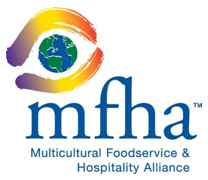  
Back
To News/PR Index
|

|
10
Website Components to Effectively Communicate Cultural Inclusiveness
|
Providence,
RI – October 2014 / Newsmaker Alert / A website is no longer primarily
an organizational window dressing but a potent tool to remain competitive
and attract a broad range of diverse talent. In a recent Website Cultural
Inclusiveness Assessment, commissioned by the Multicultural
Foodservice & Hospitality Alliance (MFHA), overall results showed
there is still much to be desired on the websites of the industry’s Top
100 Restaurants*
when it comes to communicating their cultural inclusiveness or commitment
to diversity. The goal of this study was to assess how well each respective
site projected and communicated this message. A website that actively communicates
a company’s commitment to cultural inclusion enables that company to: 1.
benefit from a better public perception; 2. support the integrity of a
brand promise that leverages cultural inclusion; and 3. enjoy enhanced
brand attractiveness to a multicultural audience of internal stakeholders,
talent, customers, partners, and the public at large.
*as
named under Nation’s Restaurant News Top 100
Based
on the results of the high scoring restaurant brands, here are 10 WEBSITE
Components to Effectively Communicate Cultural Inclusiveness:
#1
Visuals & Branding
The
use of multicultural images throughout the website, not simply limited
to a Diversity section, preferably featuring employees from underrepresented
groups, in leadership roles.
#2
CEO Message
Including
a CEO’s personal Diversity & Inclusion message, plus reasons why she
or he believes having a diverse and inclusive management team is critical
to achieving business goal, is just Best Practice. The commitment must
come from the top.
#3
Careers and Employment Page
A strong
statement of your company’s commitment to actively seeking a diverse workforce,
aided by images of employees of color, are helpful.
Written
or video testimonials of employees, management and customers, importantly,
who have seen first-hand the commitment in practice, are highly recommended.
Less
use of caricature and stock images and more use of real pictures of current
employees of color. The proof is in the pudding! Attention must be given
to updating this section every two years, if not sooner, to ensure the
image does not become dated.
Career
progression anecdotes along with an explanation of key success attributes
for candidates reinforce that you are looking for career-oriented individuals
and not just job applicants.
#4
Diversity Content – Strategy
Diversity
messaging should directly tie into overall business metrics. How do you
measure business success as related to your Diversity goals?
#5
The Overall Experience of Website Visitors
When
visiting your site, the overall experience should be consistent on each
page. The Diversity section message and visual should be consistently carried
across other related sections, e.g., “ABOUT US”, “CAREERS”, and the like.
#6
Community & Philantrophy
Your
Foundation dollars must tie into your overall Diversity strategy. Evidence
of your commitment is translated into giving back and by the organizations
you support. Best practice companies establish Diversity Councils or Committees
to ensure dedicated commitment is well thought out and monitored.
#7
Branding Your Alliances & Achievements
Showing
related organizations you support and including a brief statement of who
they are, is important to establish your support for the mission of these
organizations.
Affiliation
with relevant organizations like MFHA, WFF, Urban League, NAACP, and the
like, are important to list; display the organizations’ logos on your website
with a link back.
Feature
any related awards and other recognition.
#8
Use of Key Words
In
your content, there needs to be dedicated information and materials to
support finding key words and related phrases as: diversity, diversity
statement, CEO statement on diversity, supplier diversity, cultural inclusiveness,
multicultural, etc., when searched on your site and not just the use of
the words within general copy.
#9
Broad Accessibility
People
with disabilities should be able to access and easily navigate your site.
#10
“Tell Us About Your Overall Experience”
Encourage
feedback from those visiting your site. Include 5 objective questions and
ask for feedback that allows you to track demographics.
If
your brand has been named under NRN’s Top 100 Restaurants and you want
to know more about the research and your score, email andre.howell@mfha.net.
Culled
from a selection of sources and MFHA’s own findings: DiversityInc., DiversityBestPractices.com,
MFHA Internal Research.
The
Multicultural
Foodservice & Hospitality Alliance (MFHA) is an educational non-profit
that helps companies maximize their Return-on-Investment by engaging diverse
cultural groups through Cultural Intelligence. Learn more about how MFHA
is helping its members in the multicultural market by raising the topline,
improving the bottom-line and building cultural authenticity into the brand.
Visit www.mfha.net.
Contact:
Helga
Melgar
Marketing
& Communications Manager
The
Multicultural Foodservice & Hospitality Alliance (MFHA)
401-461-6344
x 102 |
